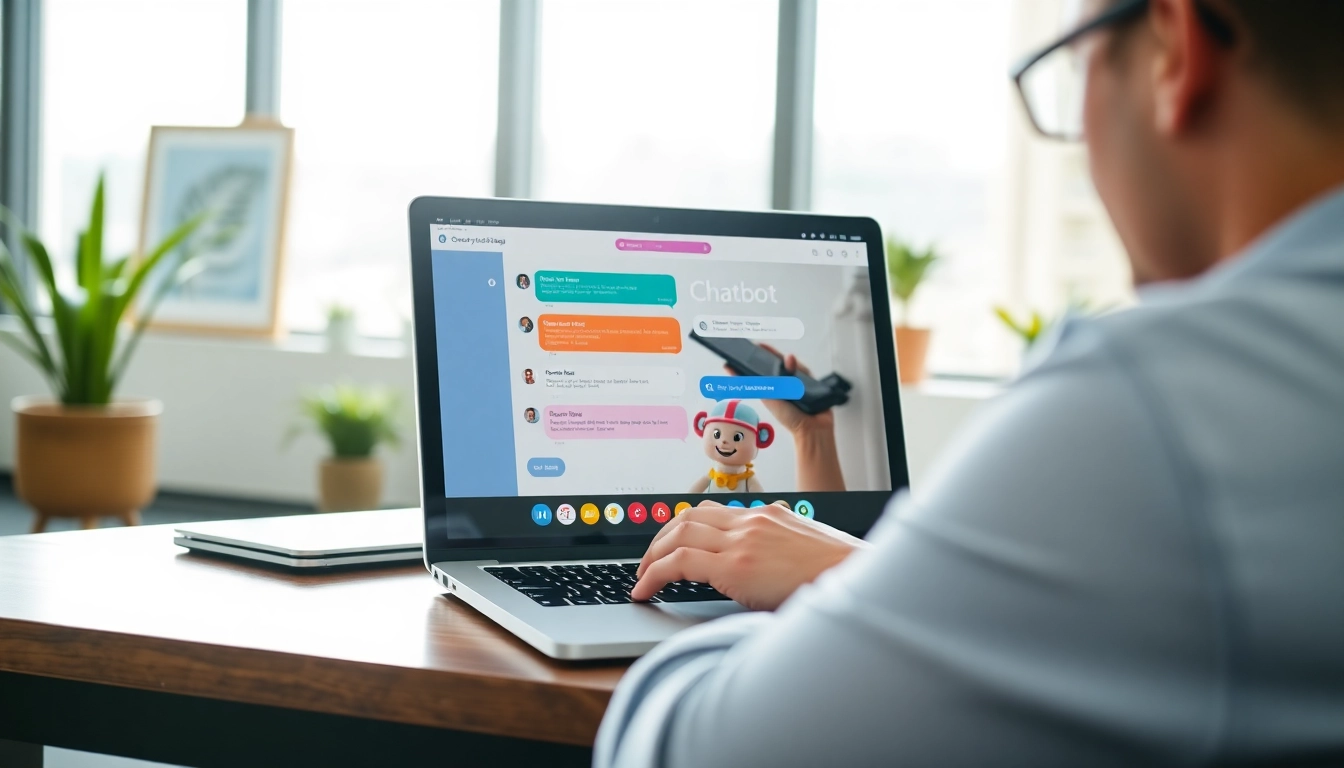Understanding the Basics of Website Chatbots
What is a Website Chatbot?
A website chatbot is an artificial intelligence program that simulates human interaction through text or voice conversations. Typically embedded on various websites (including e-commerce platforms, service websites, and more), chatbots are designed to assist users by answering questions, providing customer support, or guiding visitors through various processes. The technology utilizes natural language processing (NLP) to understand user queries and respond appropriately, creating an engaging user experience that can significantly improve customer satisfaction and retention.
One of the key aspects of a successful website chatbot is its ability to operate seamlessly across multiple digital platforms, offering consistent responses whether through a website, social media, or messaging apps. By leveraging machine learning algorithms, these bots can improve their performance over time, becoming more efficient in resolving user inquiries and adapting to varying customer preferences.
Benefits of Using Website Chatbots
The adoption of website chatbots has skyrocketed due to their wide-ranging benefits, making them essential for modern businesses looking to enhance user engagement. Some of the most notable advantages include:
- 24/7 Availability: Unlike human agents, chatbots can operate round the clock, ensuring that users receive support irrespective of the time.
- Cost Efficiency: By automating responses to common queries, businesses can reduce the workload on human support teams, significantly cutting operational costs.
- Increased Engagement: By facilitating immediate interactions, chatbots entice website visitors to engage with content, products, or services, driving higher conversion rates.
- Personalization: Advanced chatbots can analyze user data to provide tailored responses, creating a more personalized experience that resonates with individual users.
- Data Collection: Chatbots can gather valuable insights by tracking user behavior and preferences, helping businesses refine their marketing strategies and offerings.
How Website Chatbots Work
At their core, website chatbots operate on specific frameworks that enable them to interact with users. The typical functioning involves several steps:
- User Initiation: The chatbot interaction begins when a user initiates a conversation, usually by clicking a prompt or typing a message in the chat interface.
- Processing Input: The chatbot processes the user’s input using NLP algorithms to understand the intent behind the query.
- Generating a Response: Based on the understanding derived from the user’s input, the chatbot generates and delivers an appropriate response, whether that’s an answer to a common question, suggesting services, or providing troubleshooting steps.
- Continuous Learning: Utilizing machine learning, the chatbot refines its capabilities over time, learning from interactions to better serve users and improve accuracy in response generation.
Building a Website Chatbot: Key Steps
Identifying Business Needs
The first step in building an effective website chatbot is identifying the specific needs of your business and your target audience. This involves understanding what tasks the chatbot should fulfill to add value—be it providing customer support, handling inquiries, or assisting in the sales process. Conducting surveys, focus groups, or analyzing user common questions can provide valuable insights into customer needs and expectations.
Choosing the Right Technology
Once the business needs are established, selecting the right technology is crucial for developing a functional and effective chatbot. There are various platforms available, including user-friendly no-code solutions that allow businesses to create chatbots without any programming experience. Organizations must consider factors such as integration capabilities with existing systems, scalability, ease of use, and support for natural language processing when selecting a technology stack.
Designing User-Friendly Interactions
The user experience (UX) is paramount when designing chatbot interactions. The conversation flow should be intuitive, and responses should be clear and concise to minimize user frustration. User testing should be conducted to gauge the effectiveness of interaction designs and to identify any points of confusion. The incorporation of rich media elements—such as buttons, carousels, and quick replies—can enhance the engagement of the interaction, guiding users seamlessly through tasks.
Best Practices for Website Chatbots
Creating Engaging Conversations
To keep users interested, chatbots should aim to create engaging conversations by using a conversational tone and maintaining an authentic personality. This involves using language that resonates with your audience and reflects your brand’s voice. Adding humor, empathy, and contextual understanding can make interactions more enjoyable and encourage users to return.
Strategies for Successful Integration
A successful chatbot must be seamlessly integrated into your website. This means not only placing the chat interface prominently but also ensuring it operates smoothly across various devices and browsers. Provide clear instructions on how users can utilize the chatbot to facilitate their experience, and be sure to educate your audience on the value it provides in resolving their inquiries. Promoting the chatbot through your website and marketing channels can further drive usage and engagement.
Utilizing Data for Continual Improvement
Data gathered through chatbot interactions is invaluable for ongoing optimization. Businesses should track metrics such as user satisfaction, resolution time, and common queries to identify areas for improvement. Regular updates to the chatbot’s knowledge base, as well as refinement of conversation flows based on this data, ensure the chatbot continues to meet users’ evolving needs and expectations.
Common Challenges in Implementing Website Chatbots
Technical Limitations and Troubleshooting
While website chatbots provide significant advantages, they are not without their challenges. Technical limitations can arise from poor integration with existing systems, insufficient training data, or a lack of scalability. To mitigate these issues, organizations should conduct thorough testing before deployment and have robust troubleshooting processes in place to resolve issues that may arise.
User Acceptance and Experience
Another challenge is encouraging user acceptance of the chatbot. Many users may not initially trust a chatbot to resolve their queries, preferring to communicate with human agents. It’s essential to design the chatbot in a way that augments human interactions rather than replacing them. Providing an easy option to escalate to a live agent can build user confidence and satisfaction.
Data Privacy and Security Concerns
As chatbots collect and process user data, privacy and security concerns are paramount. Organizations must comply with data protection regulations and ensure that users’ personal information is safeguarded. Implementing strong encryption protocols, anonymizing data collected, and being transparent about data usage will help reinforce user trust and encourage engagement.
Measuring Success: Website Chatbot Performance Metrics
Key Performance Indicators (KPIs) to Track
To determine the success of a website chatbot, it is essential to establish clear KPIs that align with business goals. Metrics such as customer satisfaction scores, average response time, resolution rates, and user retention rates can provide valuable insights into the chatbot’s effectiveness. Benchmarking these metrics against historical performance or competitors can help identify areas for improvement.
Analyzing User Feedback and Engagement Rates
Regularly gathering and analyzing user feedback is vital for understanding how well the chatbot is meeting customer needs. This can be accomplished through post-interaction surveys and monitoring chat logs for recurrent themes or dissatisfaction points. Engagement rates should also be analyzed to determine user interactions with the chatbot, such as how often users start a conversation and how long they stay engaged.
Iterating Based on Performance Data
Finally, iteration is key to a successful chatbot. Data should guide regular updates and improvements, helping to refine the chatbot’s knowledge base, conversation flows, and integration capabilities. By continuously monitoring performance and adapting to users’ preferences, businesses can create a chatbot that not only enhances customer engagement but also actively contributes to the overall objectives of the organization.



